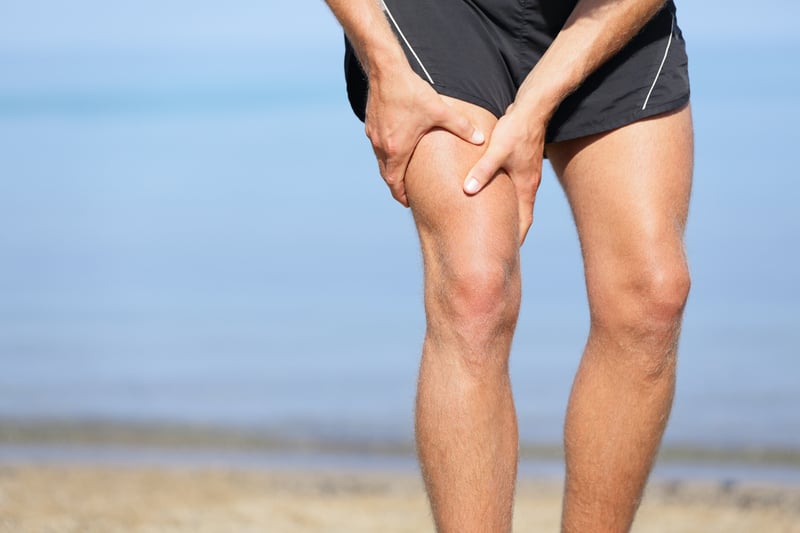Should You Still Work Out When You’re Sore?

It’s the age-old question, should you work out when you’re sore, or should you take some time off? There are actually two camps when it comes to this subject. One says yes, you can work out if you want to, but the other school of thought says you should let your muscles rest.
What should you do? Should you be working out when sore? Or, should you give things a rest? Well, what you decide will probably depend on just how sore you are and how long that soreness has been going on.
What Makes Your Muscles Sore?
Normal muscle soreness develops after you work a certain body part and usually kicks in 24 – 48 hours after your workout. You should feel only mild to medium discomfort that can be somewhat eased with a nice stretch or a gentle massage. If the soreness goes on longer than three days without diminishing, you may have pushed yourself a little too hard.
Keep in mind, there is a difference between being sore and being injured. If you notice bruising, dull throbbing pain, sharp pains, or excessive swelling, be sure to lay off the exercise, and you may want to contact your healthcare professional, especially if you are experiencing:
- an increased resting heart rate
- constant fatigue
- insomnia
- mood changes (e.g., depression)
- increased number of illnesses (e.g., colds, flus, and upper respiratory infections)
- overuse injuries
- decreased appetite
- muscle or joint pain
- decreased athletic performance, even after taking time off
Sore muscles are part of the story when you work out on a regular basis. But, did you ever stop to think about what makes your muscles sore and how you can minimize the soreness or speed up the healing?
What Makes Muscles Sore After a Workout?
Delayed Onset Muscle Soreness (also known as DOMS) is something you will no doubt experience if you spend any time at the gym. When you work out a muscle, what’s happening is that you’re putting microscopic tears into the fibers of the muscle. This can cause pain and, when accompanied by some inevitable minor swelling, can be an uncomfortable condition that can last several days.
Don’t panic though. This is completely normal! Yes, it does sound awfully strange, and even bad for you, but it’s not. Tearing and rebuilding the muscle fibers is exactly how you build muscle, and it’s part of the process of toning and honing your physique.
So, should you give it a rest? Two different theories
Camp #1: No, You Should Not Work Out When Sore
There are those who say you need to take a break if your muscles are sore. The normal theory is that the sore muscle is still recovering and being repaired and needs time to heal (usually a couple of days) before being taxed again.
And, this theory is not wrong. Yes, it’s a great idea to give your muscles a break and work on different areas until the soreness subsides. Too much of a good thing is a possibility when you’re too gung ho in the gym. It’s best to avoid straining, spraining, and tearing, and sometimes a brief period of rest is exactly what the doctor ordered.
Camp #2: Yes, You Should Work Out
On the other hand, there are some studies that show laying low and not moving around when you’re sore can actually be less helpful than getting up and getting in a gentle workout. It can be better to move around than to sit around and let your muscles stiffen up.
You can gently stretch and work your sore muscles while your body is primed for a workout and fully warmed up. This can help ease some of the pain, although simple stretching itself won’t necessarily prevent DOMS from occurring in the first place. If you do choose to work out the sore muscles, take care to reduce your usual workout intensity, do different exercises than you did before (the ones which caused you soreness), and don’t push it too long—shorter interval exercise is better in this case.
And, while you’re sore, it’s still okay to work out other body parts. In fact, it’s a great idea. This is why you’ll often see athletes divide their workouts into sessions with various body parts worked on different days. A typical example of such a workout is the common body part split:
- Chest/Shoulders/Triceps
- Back/Biceps
- Legs/Calves/Abs
Such a split allows the muscles a bit of relief and healing time in between exercise sessions and can be a great way to avoid and prevent injury and overuse.
So, Your Muscles Are Sore… What Should You Do Now?
Okay, now you’re dealing with DOMS, and it’s time to figure out what to do.
Active Recovery—you’ve undoubtedly heard of active rest days… well, in the same vein, active recovery is using the muscles that are sore, but not pushing them to the max. You can do activities that gently stress the muscles that are sore, such as walking, a light jog, a swim, or a bike ride. This still allows the blood to flow and heal the muscle tissues without overtaxing already sore areas.
Stretching—try doing some gentle stretching. The affected area could most likely benefit from the additional blood flow and to help break the cycle of muscle spasm to tightening to stiffness.
Rest—yes, if you don’t want to do any of the above, it’s also okay to take a rest day. Your body also needs time to rest, repair, and replenish, and taking a day or two off, or at least not working the muscles that are sore, can do a body good.
Split Up Your Body Parts—the easiest way to organically overcome DOMS and to avoid overtraining any specific area is to split up your body parts so that several days elapse between training sessions for each body part.
Ice—you can always apply ice to sore muscles to help calm and heal the area. If available, a cold whirlpool as well as contrast therapy (alternating ice and heat) can also be highly effective for helping relieve DOMS.
Heat—physical therapists often use heat immediately after exercise to help prevent DOMS. Moist heat is recommended over dry heat as it provided enhanced benefits at least in some cases while taking only 25% of the time.
Epsom Salt Bath—it may sound strange, but a warm bath with Epsom salt can help relieve muscle soreness. Plus, the wet heat will be relaxing and promote healing.
Massage—this can also help ease your soreness as it helps increase circulation which can help the area heal more quickly.
How to Prevent Soreness
To help prevent or at least minimize DOMS before it happens, remember to take a few minutes to warm your muscles up before your workout, stretch between sets, and then remember to cool down with 5 to 10 or so minutes of easy movement (a light walk or jog, for example) to bring your heartrate down followed by 5 to 10 minutes of stretching to help clear out the lactic acid. You can also try using a foam roller to help release muscle tension.
And if you’re starting a new exercise program, or if you’re new to exercise altogether, start slowly and gradually increase how often and how hard you work out. (Of course, remember to check with your healthcare professional before starting any new diet or exercise routine.)
While there’s no denying the value of a regular, consistent, and balanced exercise program, remember to include rest and recovery days into your schedule to give your muscles the time they need to recover and come back even stronger to your next workout!







